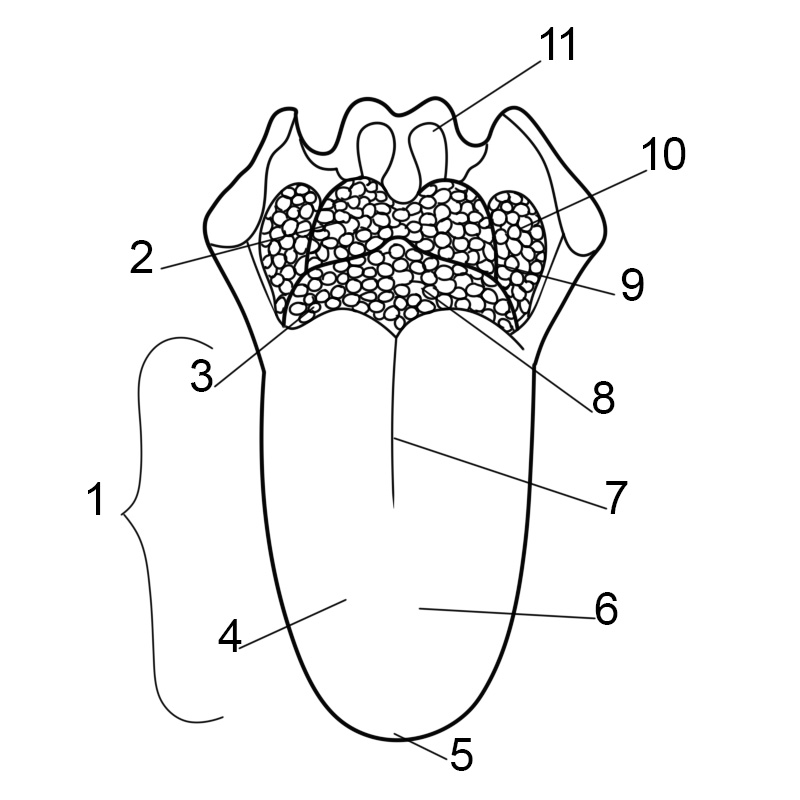The tongue refers to a muscular organ found in the mouth of most vertebrates. It manipulates food for the process of chewing and is used in the swallowing process. Amongst all our senses of taste, the tongue is the primary organ of taste. The tongue also plays a very big role in the system of digestion. The upper surface of the tongue known as the dorsum is covered by taste buds. These taste buds are housed in many lingual papillae. Saliva keeps the tongue moist and it is a very sensitive organ. The rich supply of blood vessels and nerves makes the tongue sensitive. The tongue also serves the purpose of naturally cleaning the teeth. Another major function of the tongue is the vocalization of animals and enabling speech in humans.

The human tongue has two parts, the oral part, and the pharyngeal part. The oral part is located at the front and the pharyngeal part is located at the back. The lingual septum is a fibrous tissue that vertically separates the left from the right side of the tongue.
The human tongue has the anterior and posterior parts. This division is by the terminal sulcus that is a groove with a V shape. These parts vary in terms of their nerve supply and embryological development.
Anterior and posterior part of the tongue
The anterior tongue is at the tip of the tongue. It is narrow and thin and directed forward against the lingual surfaces of the lower incisor teeth.
The posterior part is found at the root of the tongue. It is directed backward and joined to the hyoid bone by the genioglossi and hyoglossi muscles and the hyglossal membrane.
The average length of the tongue in humans from the tip to the oropharynx is 10 cm. The average weight of the tongue in humans (adult males) is 70g and 60g for adult females.
In phonology and phonetics, a differentiation is made between the blade and the tip of the tongue. The blade is the portion of the tongue found just behind the tip.
Upper surface and undersurface of the tongue
The upper surface of the tongue is called the dorsum, and it is divided by a groove into symmetrical halves by the median sulcus. The foramen cecum marks the end of this division (at about 2.5 cm from the root of the tongue) and the beginning of the terminal sulcus, which divides the tongue into anterior and posterior parts.
The undersurface of the tongue has a fold of mucous membrane called the frenulum that attaches the tongue at the midline to the floor of the mouth. There are small prominences on either side of the frenulum, these are called sublingual caruncles that the major salivary submandibular glands drain into.
Muscles in tongue
The muscles of the tongue are of two groups, four intrinsic muscles, and four extrinsic muscles. The four intrinsic muscles change the shape of the tongue and they are not attached to bone. The four extrinsic muscles that are paired change the tongue’s position and they are anchored to bone.
The extrinsic muscles originate outside of the tongue and inside the oral cavity, and insert into the tongue itself. They are the genioglossus, hyoglossus, styloglossus, and palatoglossus muscles.
The intrinsic muscles are placed completely within the bulk of the tongue. They are the superior longitudinal, inferior longitudinal, transverse, and vertical muscles.
The lingual artery primarily supplies blood to the tongue. This artery is a branch of the external carotid artery. The lingual veins are responsible for draining blood from the tongue into the internal jugular vein. The lingual artery also supplies blood to the floor of the mouth. The secondary supply of blood to the root of the tongue also exists. Blood is supplied to the tongue from the facial artery’s tonsillar branch and the ascending pharyngeal artery.
Innervation of the tongue consists of motor fibers, special sensory fibers for taste, and general sensory fibers for sensation.
Motor supply for all intrinsic and extrinsic muscles of the tongue is supplied by efferent motor nerve fibers from the hypoglossal nerve with the exception of the palatoglossus, which is innervated by the vagus nerve.
Innervation of taste and sensation is different for the anterior and posterior part of the tongue because they are derived from different embryological structures.